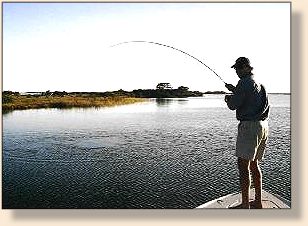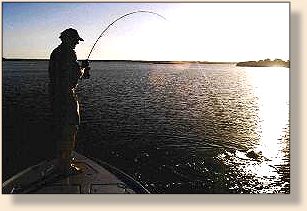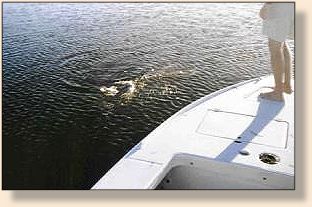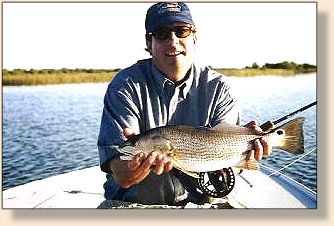There is much to suggest that Man survived amongst the
other creatures of the world because he is both smart
and erect. Were it not for his superb self-programming
computer of a brain, the freedom of his dexterous upper
extremities to make tools and throw weapons, the elevated
position of his sentient eyes, ears, and nose, and his
ability to deliver information and express feelings by
a remarkable combination of sounds and facial movements,
he would not have survived long in the jungle. Small
wonder, then, that his head, which houses these vital
sources of thought, perception, and communication, holds
the highest place not only in his body but also in his
concept of himself.
So, it is small wonder that a medical device company
executive would call me at 10:30 am searching for a way
to fulfill a lifetime goal: catch his first redfish on
fly. This is truly fishing fever. It is a desire that
doesn't fade with time. Michael is one of the few
charters clients who is determined to catch everything
with fins on fly, especially in saltwater, and especially
on the flats.
"Captain, It's Michael, I'm on the road. I just finished
my meetings in Jacksonville and I rented a car. I can be
in New Smyrna by noon so can you fit me in for an afternoon
charter? I just need to know where I can pick up some
shorts and a shirt. Can you fit me in this afternoon?"
"You bet I can!"
I first met Michael at a clinic I was doing for the Fly-Fishing
Campfire in Ocala last March. His casting was reminiscent of
a stream fisherman and not suited too well for long distance
double haul casting on a saltwater flat. But we would soon
correct that and he would be mastering a 80-foot cast in no
time at all.
He met me at the Canaveral ramp. While other guides were just
returning with their charters, we were launching. You could
see the anticipation in Michaels face. He was eager to get
out on the water. Sight fishing in the late afternoon is
especially good in Mosquito Lagoon, but poses different
challenges as the light disappears. Redfish and Spotted
Sea Trout are not as pressured and freely move along the
mangroves. I prefer late afternoon fishing. Sighting fish
is interesting as the sun starts to set. The water is
usually calm and this is perfect for sighting a push from
a long distance, way before you actually see the fish.
We moved quickly past Eldora State House south passed Pumpkin
Point. I shut down just past the Goodrich Lease (an oyster
harvesting area). We drifted south, with occasional steerage
adjustments from the push pole to position us into a favorite
flat. I was surprised at the water depth on the west side
of the channel. It was about four feet deep. Maybe this
is where all the water in the lagoon has gone. In twenty
years fishing this area I've never seen Mosquito Lagoon so
high.
As we started into the flat, you could see the pushes of
large fish patrolling the mangroves for baitfish and shrimp.
Some large tiger shrimp were actually jumping out of the water.
They make a sound like water dropping from a pail.
Michael got on the casting platform and scouted the
shoreline and water as I poled us ahead.
"Michael. Two o'clock about fifty feet. Pushing from
your left to right. Hold and I'll position the boat
for a leading cast."
Michael let go of the Borski Slider, the fly line and
started his cast. The trailing fluorescent blue Royal
Wulff fly line hissed through the rod's guides. It painted
a light colored flashing line in contrast to the dark areas
on the horizon. Only one false cast and the fly dropped
silently into the water next to the mangroves, leading
the redfish by at least 10 feet.
"Michael, let it sink."
"OK, start your strip. Nice and easy."
But there was no hook up and the redfish swam right by the fly.
"Wow! Did you see him? What a magnificent redfish!"
replied Michael.
Then came another push along the same edge. Michael
started his cast and led the next fish. But nothing
happened, no hook ups. So we pushed on, deeper into
the flat in an area where trees blocked the western
sunshine. Quietly and very slowly I poled along the
shoreline. Michael every ready at the bow, waited for
the first sign of movement. But none would come for
at least another hour. Back deep into the flat and
away from the trees we let the boat just stop and settle
into the late afternoon.
The sun was just starting to set, dipping down ever closer
to the far horizon. The water was flat as glass. Deep
into the mangroves a family of eight raccoons made their
way along a ditch. The glanced up at us and then kept
moving. The little coons tagged along trying to keep
up with their parents. Shorebirds munched on food in
the shallow water. I started to pole again and turned
the boat towards a small creek in the northeast corner
of the flat. Suddenly we could see a huge push. At first
I thought it might be a trout. But the high arching
push could only be from a redfish. The push is unmistakable.
Redfish arch their backs when moving quickly through shallow
water. Even a small redfish can appear like a large fish.
I'm sure we spooked this fish as I started to get the boat
moving again. So I stopped and waited to see which direction
the redfish would go. He turned and then started back towards
us. I staked off the boat and we waited quietly as the redfish
started back coming into casting range.
At fifty feet, Michael made his first cast and let the fly
settle. The redfish didn't slow down. He just motored right
past the boat and back to the front of the creek opening.
Hunting redfish can sure be frustrating at times.
The thought crossed my mind that maybe he couldn't see the
fly. Maybe we needed a little more flash. Maybe Michael
was wearing the wrong hat. So we changed flies to a pink
and yellow buck tail (my favorite trout fly). And, we
changed his hat (my favorite Backcountry Flyfishing).
On the next pass, Michael sent out the most beautiful
seventy-foot cast that I'd ever seen him throw. He waited
for the fly to sink, did one strip and scored with a hook up.

Rod tip pointing toward the shimmering surface, the redfish
took off on a short run, and the reel was singing. Michaels'
grin was from ear to ear. He played the redfish like a master.
It is a feeling you never forget, especially on a strong redfish.
Michael held on to the rod as the redfish made runs out to
the opening of the flat, across to the mangroves and then
back to the boat. This action was repeated a couple of times.
We wanted to shorten this fight and get him to the boat quickly
for a picture and release. Michael applied side pressure to
the rod to slow the redfish down. He just kept up the run.
With 12-pound tippet we had to be careful or we would loose
this fish. The 8-wt DFR handled this fish with ease.

"Nice. Keep the tip up." Finally we were able to pole to the
redfish.

This is what the art of fly-fishing is all about. With
the fish in the water, I wetted my hands and then lifted
him into the boat to remove the fly, take the picture,
release and watch him swim away.

This was the end of a perfect day for Michael. Was it his
casting? Was it the fly? Or, Was it the 'Lucky Hat?' It
doesn't matter. What matters is being there. Being out in
nature. Enjoying the reverence of a late afternoon fishing
adventure to stalk and fight one of the best game fish in
Florida - Redfish.
For many fly-fishing anglers, the challenge of presenting
a fly to a wary fish and having him eat it is more than just
putting food on the table. Next time you are out fly-fishing
with me we need a new lucky hat. Michael still has this one.
Enjoy the outdoors. Practice catch and release. ~ Doug
About Doug
Capt. Doug Sinclair has relocated from New Smyrna Beach, Florida to
Grantsboro, NC. He specializes in fly-fishing and light tackle charters.
Doug charters the Coastal Carolina area of New Bern or Oriental.
Catch him on the web at
www.flyfishacademy.net or call him at (252) 745-3500.
Doug is also a Sponsor here on FAOL.
|





